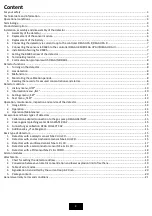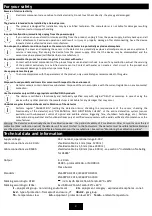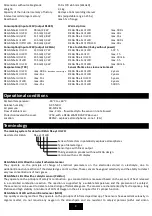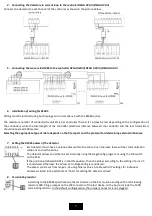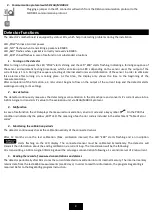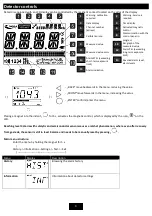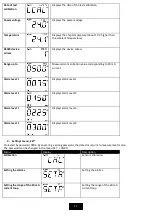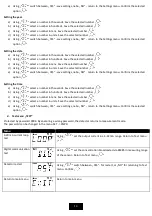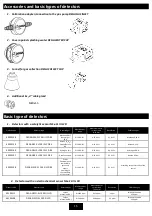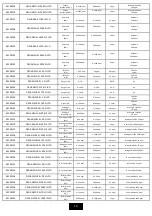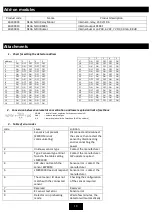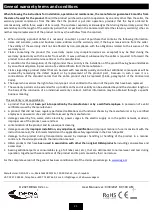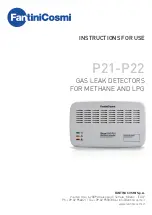
14
Operation, maintenance, inspection and service of the detector
1.
Usage limits
To maintain proper operation of the detector it is neccesery to respect the fact, that step changes of humidity, condensation
or rapid changes of pressure can cause incorrect indication of the measured value. Each sensing technology is suited for
different methods of application, which is described below. All sensors are characterized by a smaller or larger cross-sensitivity
to other gases than those which are set. Therefore before processing project documentation we recommend to have the air in
the deployment area of the detection system analyzed.
a)
catalytic sensors:
Trace amount of vapors of silicon compounds and sulfur compounds cause a permanent loss of sensitivity,
which requires recalibration or replacement of the sensor. Longterm crossing of the measuring range causes a decrease in
sensitivity. In case of an atmoshpere having an oxygen content of less than 17 %, there will be an underestimaton of the
measured value. In case of an atmoshpere having an oxygen content of more than 25 %, there will be an overestimation of the
measured value.
b)
electrochemical sensors:
Constant exposure to toxic gases or short-term exposure to gases, which greatly exceed the
maximum range of the sensor, can damage the electrochemical sensor, which requires recalibration or replacement. High
temperature along with low relative humidity have a negative effect on the sensor's lifetime. In case of an atmoshpere having
an oxygen content of less than 1 % for longer than 1 hour, there will be an underestimation of the measured value.
c)
infrared sensors:
Vapor acids and alkalis can etch the optical system and distort the measurements. A check or a calibration
may be neccesery.
d)
semiconductor sensors:
Short-term exposure to gases or vapors of organic solvents, which greatly exceed the maximum
range of the sensor, may damage the sensor and a recalibration or replacement may be required. In case of an atmoshpere
having na oxygen content of less than 18 %, there will be an underestimation of the measured value.
e)
photoionization sensors:
the UV lamp or sensor must be replaced regularly, its clogging may cause loss of signal.
2.
Operation
To maintain proper operation of the detector it is neccesery to respect the fact, that the presence of certain concentrations of
gases or vapors, other than those for which the sensor is set, can cause an alarm, even if the concentration of the gas does not
exceed the set level. Given the range of disturbing gases or vapors (diluents, exhaust gases, vapors of organic substances,
disinfectants, etc.) a generally allowable concentration of interfering gases can not be determined. Data on cross-sensitivity to
certail gases are included at the apporpriate sensors. Therefore before processing project documentation we recommend to
have the air in the deployment area of the detection system analyzed
.
3. Operation/Maintenance
In case of contamination the surface can be cleaned with a slightly moistened cloth.
The seonsors have a different lifetime depending on the sensing technology used, and environmental conditions.
Characteristics of the sensors vary over time. Therefore it is required to perform regular checks and calibrations, which can be
done in two ways:
a)
1 x every six months
carry out a „
calibration“ and functional control -
adjust the sesitivity of the sensor using
calibration gas and check the functionality of the system. The exact interval depends on the purity of the environment,
required accuracy and the occurrance of disturbing gases in the atmoshpere
.
b)
1 x every twelve months
carry out a „
calibration“ -
adjust the sesitivity of the sensor using calibration gas and check the
functionality of the system. The exact interval depends on the purity of the environment, required accuracy and the
occurrance of disturbing gases in the atmoshpere. Also carry out a
„functional control" 1 x every three months -
checking the function of the entire detection system using a test gas, which does not exceed the range of the sensor.
We recommend using gas intended for laboratory use
.
For the „functional control“ do not use means for testing fire alarm detectors!
Perform calibration only at certified service centers with a valid certificate of competence or the manufacturer.
For the Czech Republic only DEGA CZ s.r.o.


